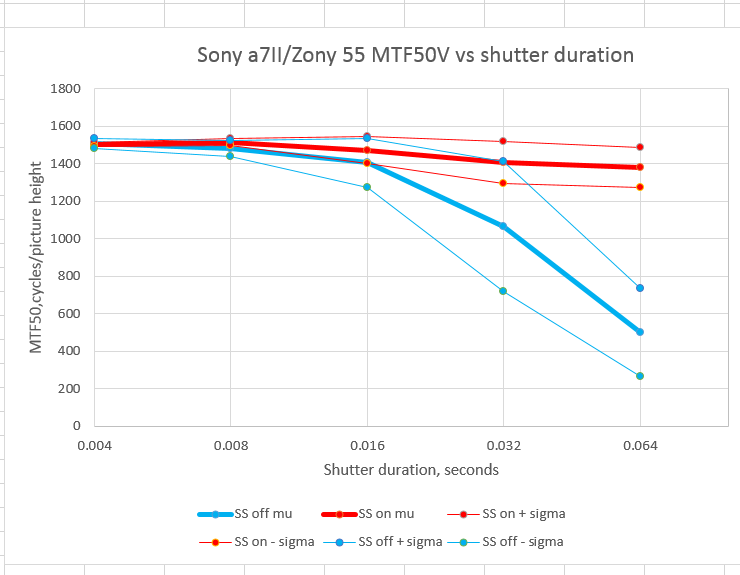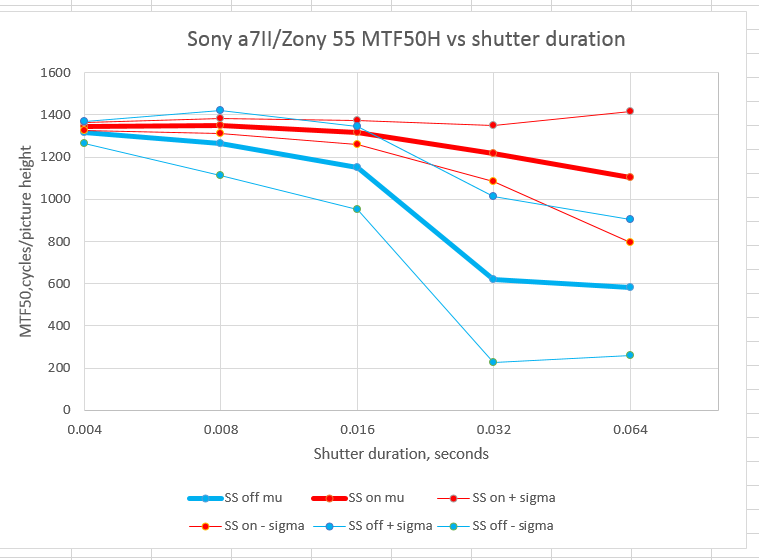There are many small improvements in the Sony alpha 7II over the alpha 7 which it replaces. There is one big one: the in-body stabilization system (IBIS), which Sony calls SteadyShot. It has the potential to reduce the effects of camera motion somewhat when used with lenses that have optical stabilization, and a lot in lenses that don’t.
How well does it work?
I employed a test protocol based on one I developed some time ago for measuring the effect of shutter vibration on handheld image sharpness.
- The camera: the Sony a7II.
- The lens: the Sony/Zeiss (aka Zony) 55mm f/1.8 Sonnar FE.
- The filter: Heliopan 77mm variable neutral density.
- The lighting: a single Fotodiox LED-200WA-56 daylight balanced flood.
- ISO set to 800, f-stop set to 8,
- Focusing in single shot AF mode with the medium focus area setting,
- Drive set to single
- EFCS on
- Manual exposure mode.
- Hold the camera in the “Pete Souza” grip: left palm under base, left fingers bracing the underside of the front part of the lens, elbows against chest.
- Exposure protocol: ND filter to minimum attenuation,, shutter to 1/250 second, make 16 exposures with new focusing for each, ND filter down a stop, make 16 exposures… until you get to 1/15 of a second or so.
- Inhale, exhale, brace, think calm thoughts, squeeze the shutter release, remembering to “pull through”.
- Develop in Lightroom 5.7.1 with standard settings.
- Crop, export as TIFFs, analyze for horizontal edge and vertical edge MTF50 in Imatest.
- Export the results to Excel, crunch the stats, and graph.
The envelope, please:
The vertical axis is the MTF50 for the image: the point where, as the spatial frequency of the subject matter increases, the response on the sensor is reduced to half its very-low-frequency value. The units of spatial frequency are cycles per picture height. Since the a7II has a picture height of 4000 pixels, the highest that the MTF50 should ever get is under 2000 cycles per picture height. 1500 is exemplary performance. Lr does do some deconvolution filtering, which increases MTF50.
The horizontal axis is the shutter duration. 0.004 seconds, the number at the left edge, is 1/250 second. 0.064 is 1/15 second.
The heavy lines are the average for all 16 exposures. The red is with IBIS on, and the blue is with it off. The light lines are the average plus one standard deviation and the average minus one standard deviation. If the statistics for handheld MTF50 turn out to be Gaussian, about two thirds of the images will fall between the two narrow lines.
The top curve is horizontal resolution (vertical edges), and the bottom for the vertical resolution (horizontal edges) I held the camera in landscape orientation. The reason the vertical numbers are larger than the horizontal ones is that the Sony a7II, like the a7, has an anti-aliasing filter that is stronger horizontally than vertically. In fact, in both cameras, it doesn’t seem like the AA filter does much of anything vertically.
What are we to conclude from these curves? Here’s what I think
1/15 second is marginal with SteadyShot on, and just plain soft with it off.
1/30 second is OK with SteadyShot on, and just plain soft with it off.
1/60 second is good with SteadyShot on, and just marginal with it off
When we get to 1/125 and 1/250 second, SteadyShot makes a small improvement in the average image sharpness. But look at the difference in the spread between the mean-plus-standard-deviation and mean-minus-standard-deviation lines! Steady shot provides a lot more confidence that any given expose will be tack sharp. That’s worth a lot
Two thumbs up.


Great post, Jim. I adopted IS tech reluctantly, but I have gradually come to rely on it for best image quality in hand-held photography. So often camera shake is the weakest link in the imaging chain.
There are still many who insist that IS, with its constantly-moving elements or sensors, is incapable of, or at least unreliable in reaching, the highest level of image quality. (Zeiss is often quoted as an authority to support this.) But your test, like my own experience, gives no evidence that this argument is valid.
Best wishes, –d
Thanks Jim,
You have confirmed my fears. Sony cannot built in the IBIS- Olympus type. FF to MFT is twice bigger! Consequently, any rule of thumb: the shutter speed at Oly – twice for fullframe! Example: If with an Oly digicam 1/50s is good, then for FF 1/100s will be good!
On the other hand, the IBIS will be very important for the new 46MP sensor! Not for shooting with 1/25s, but with 1/125s for sharpening!
Did you already factor in the crop factor? When I compare the Sony with 135/1.8 to the EM1 with 60mm macro (120mm equiv.)
I can go to 1/16-1/32s on the A7ii with high confidence and get sharp shots at 100%. Similar for the Olympus for me. My feeling is I get 3-4 stops with 5-axis and 2-3 stops for 3-axis (manual lens w/o distance information) with the Sony. Quite good in my opinion. The Oly is only slightly better for my way of shooting.
That is a role of thumb! Also, it depends on how someone shiver, it’s windy or not, it has strong reflections etc., and the choice of the lens.
It could go till 3-4 stop, but everyone has to try it himself with his equipment!
Dear mr. Kasson,
Do you plan to repeat this very useful test with any wideangle lens? I’ve done some brief testing and I feel that f/stop gain is slightly lesser with WAs.
How wide would you like?
28 or 35 should be enough, thank you. Manual lenses, if possible.
OK. I’ll do the 28mm Elmarit-R.
Great, thank you sir.
Great job! First scientific IS test I have ever seen.
PLEASE PLEASE do such tests with longer lenses! I did not see any meaningful test @ longer than 85 mm while it is tele range that needs the IS most. The particular lens model is irrelevant. For the complete picture, I think it would be enough to see the results @ 70-85, 135-150, 250-300 and (optional) 400-600 mm.
Here’s a test with a 180mm lens:
http://blog.kasson.com/?p=8358
The long lenses that I use much, the 400/2.8 and the 200-400/4, are too big and heavy to handhold.
Jim
Thank you for the point. Impressive, good 2.5 stops there. As to the longer lenses, what about a zoom like the 70-300G or 100-400G? Their resolution at the long end is lower than that for primes, yet I guess it should be adequate for the test.
An excellent test, and full marks for testing it with a ‘good’ camera hold!
But as a long-time user of Sony IBIS I can tell you that IBIS doesn’t behave exactly the same as OSS. In particular IBIS has a quite limited amplitude range of correction and also the rate of wobble (dx/dt, dY/dt) is limited. If the amplitude and rate of the wobble is within the correction capability of IBIS – and so long as it stays within it – the IBIS can achieve miraculous results. I’ve had a 4-stop improvement in blur for around 70% good shots with a long tele, eg 1/20 sec at 400mm-500mm on APS-C.
But if the amplitude of the wobble exceeds the correction limits – even briefly – the whole thing fails and you may see little improvement. Therefore the benefit you get is heavily dependent on the lens (eg its physical length – the longer the better, as the wobble rate goes down) and the way you hold it (you need to minimise the total amplitude of the wobble).
So IBIS *can* work very well with a small and poor tripod that gives some wobble, though if the tripod is very stiff the tiny wobble that is still there is too fast for the IBIS to follow accurately and it can make things worse, hence the recommendation to turn it off.
I wouldn’t be without it in poor light – I can get (some) exposures of 1/4-1/8 sec pin sharp at night with a normal lens – but it doesn’t work for everyone all the time.